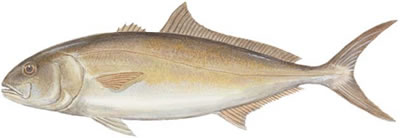The greater amberjack is the largest of the jacks, the most important amberjack to anglers, and, like most of its brethren, a strong fighter. It is high on the list of tropical marine fish suspected of causing ciguatera poisoning, although this problem may be isolated to certain areas.
Identification
This fish is greenish-blue to almost purple or brown above the lateral line and silver below the lateral line. A dark olive-brown diagonal stripe extends from the mouth across both eyes to about the first dorsal fin. A broad amber stripe runs horizontally along the sides. The fins may also have a yellow cast.
The greater amberjack has short foredorsal fins, a bluntly pointed head, and no detached finlets. The amber stripe sometimes causes anglers to confuse the greater amberjack with the yellowtail, but it can be distinguished by the 11 to 16 developed gill rakers on the lower limb of the first branchial arch; the yellowtail has 21 to 28 gill rakers.
Size
Averaging roughly 15 pounds in weight and commonly ranging up to 40 pounds, the greater amberjack often weighs more than 50 pounds and has been reported to exceed 170 pounds. The all-tackle record is 155 pounds, 10 ounces. It can reach a length of more than 5 feet.
Life history/Behavior
The greater amberjack often occurs in schools, but it is not primarily a schooling fish and occasionally remains solitary. Migrations appear to be linked to spawning behavior, which in the Atlantic occurs from March through June. Evidence suggests that spawning may occur in offshore oceanic waters, but few studies have been conducted, although spawning fish are known to congregate over reefs and wrecks.
Food and feeding habits
Greater amberjack feed on fish, crabs, and squid.
Other Names
amberjack, jack, amberfish, jack hammer, horse-eye bonito, horse-eye jack, Allied kingfish (Australia); French: poisson limon, sériole couronnée; Hawaiian: kahala; Japanese: kanpachi; Spanish: coronado, pez de limón, serviola.
Distribution
In North America greater amberjack occur off Hawaii, off the coasts of Florida, and in nearby Caribbean waters. Amberjack in some waters are resident fish, but others are migratory coastal pelagic fish that swim with the current edges and eddies.


